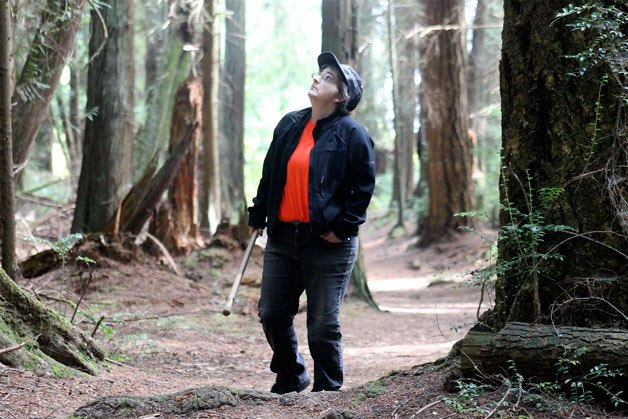A South Whidbey woman is now looking up in the trees rather than down at the trail after a frightening encounter with an aggressive owl in Saratoga Woods.
Clinton resident Melissa Ross was participating in Whidbey Island Rocks — a search for hidden, painted rocks around the island —at around 4:30 p.m. Aug. 11 near the entrance of Saratoga Woods when she saw a shadow of something approaching her from above. In the next instant, her hat was knocked to the ground by a white owl with black spots and yellow eyes. By the time she picked her hat up, the owl was priming for another run. Ross would spend the next 30 minutes fending off the continually attacking bird with a large branch in a slow retreat back to her car.
“That’s the only way I could get out,” Ross said.
The owl, which she estimated as being about 2 feet tall with a 3-and-a-half-foot wingspan, dive-bombed her over two dozen times, she said.
Ross posted a warning the next day on ”Alert Whidbey,” a community Facebook page. Though a first response was a lighthearted “That’s a hoot!” comment, Ross said it’s no laughing matter. She considers the incident a traumatic event.
“I’ve been having dreams about it,” Ross said. “A lot of people come out here and the way he attacked me, I didn’t want some unsuspecting mom with a child [to be attacked].”
Frances Wood, a South Whidbey bird watcher and columnist for The Record, said Ross’ description of the owl matched that of the great horned owl. Wood and other experts also theorized that the owl was young. When juvenile owls leave the protection and comfort of their parents, they begin “learning how the world works,” Wood said.
“The owl isn’t attacking a person any more then it is attacking any critter that heads its way,” Wood said. “It would go after other owls, raptors, a raccoon, or anything threatening it.”
“My guess is that it’s just sort of the fall dispersal of owls and they’re finding their own niche in the world,” she added.
Alina McClain of South Whidbey Animal Clinic in Clinton said juveniles sometimes become aggressive when learning hunting behaviors.
Another theory is the owl was an adult confused by the late summer daylight hours, said David Parent, a veterinarian at the Useless Bay Animal Clinic. Because hours of daylight at the end of summer are nearly identical to those during the springtime nesting season, the owl may have been controlling its territory, he said. He also agreed with the juvenile theory, though he said barred owls are normally the culprit in attacks and not great horned owls.
“Barred owls are a fairly recent bird to come here and they’re almost always the perpetrators,” Parent said. “They think it’s a prey item, but once again it’s a young, stupid bird doing that.”
Parent said barred owls are becoming somewhat of a problem on South Whidbey. He said they may be responsible for the extinction of screech owls on Whidbey Island, and that they are eating smaller owls and possibly threatening spotted owls.
Based off the description of the attack, Wood suggested the owl was utilizing scare tactics. Something peculiar, however, happened when Ross was near the exit.
“He got up on that limb on the last tree and tried to keep me from leaving the woods,” Ross said. “That’s when I knew there was something wrong with him.”
Ross thought the owl may have had rabies. Though owls have antibodies to protect themselves against the disease that causes madness and convulsions in certain animals, it would be extremely rare, McClain said.
“They got exposed to the virus and their body responded to it, but it doesn’t mean they contracted the disease of rabies,” McClain said.
To avoid being taken off-guard by owls, Wood urged would-be trail walkers of the Saratoga Woods to be aware by keeping their eyes up and wearing a hat for protection from an owl’s talons. She also said that using different entrances to the woods may be another safe alternative. If an owl encounter does occur, Wood said people should retreat slowly and gently — it may also give a person a chance to observe the bird. She considers seeing them as “really, really cool,” and that owls are utilizing nature just as humans do.
“They are moving around and they’re dispersing,” Wood said. “Give the owls a chance.”



